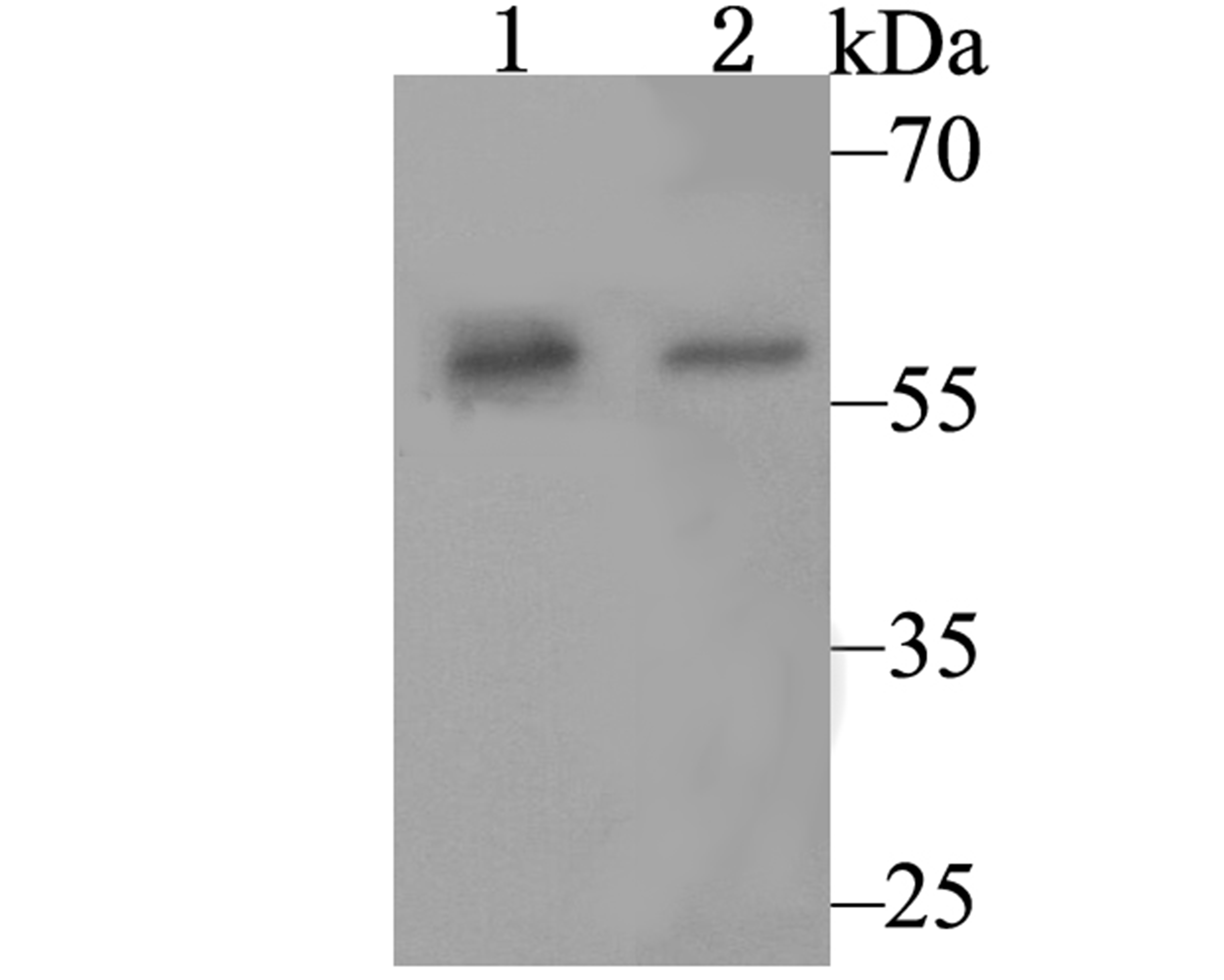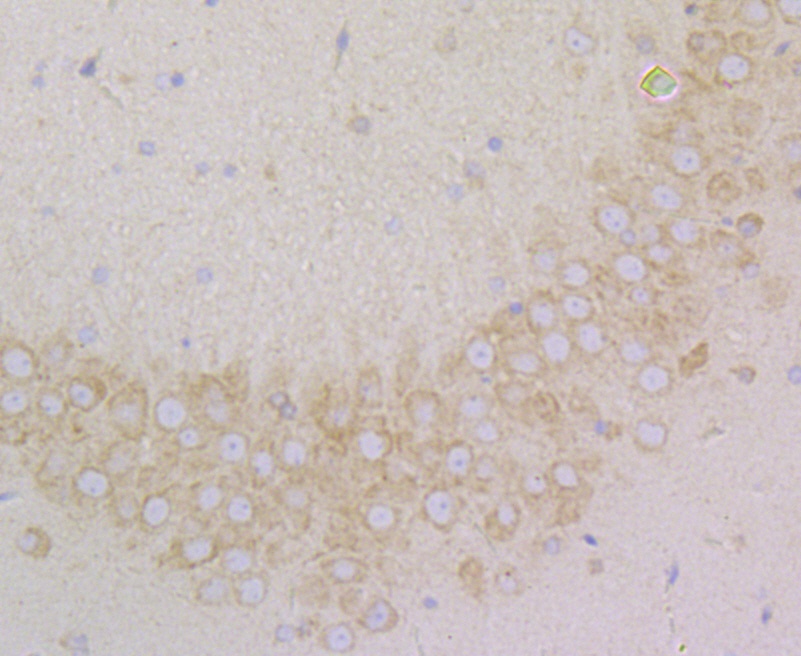Product Name :
SRP54 polyclonal antibody Background :
SRP54, a component of the signal recognition particle (SRP), recognizes the signal peptide of secretory proteins and interacts with the signal recognition particle receptor to target the ribosome and the associated nascent chain to the endoplasmic reticulum. By functional analysis showed that SRP54 binds to SRP RNA via the M-domain, but only in the presence of RNA-bound SRP19, and that it associates with the signal peptide of nascent polypeptide chains. RNA interaction requires the presence of a loop in the C-terminal M-domain. Signal peptide recognition most likely involves methionine-rich loops. During signal peptide recognition, SRP54 is positioned at the exit site close to ribosomal proteins L23a (602326) and L35. When SRP54 contacts the signal recognition particle receptor (182180), SRP54 is rearranged such that it is no longer close to L23a. This repositioning may allow the translocon to dock with the ribosome, leading to insertion of the signal peptide into the translocation channel. Product :
Rabbit IgG, 1mg/ml in PBS with 0.02% sodium azide, 50% glycerol, pH7.2 Storage&Stability :
Store at +4℃ after thawing. Aliquot store at -20℃. Avoid repeated freeze / thaw cycles. Specificity :
SRP54 polyclonal antibody detects endogenous levels of SRP54 protein. Immunogen :
Recombinant protein within human SRP54 aa 1-200. Conjugate :
Unconjugated Modification :
Unmodification
SRP54 polyclonal antibody Background :
SRP54, a component of the signal recognition particle (SRP), recognizes the signal peptide of secretory proteins and interacts with the signal recognition particle receptor to target the ribosome and the associated nascent chain to the endoplasmic reticulum. By functional analysis showed that SRP54 binds to SRP RNA via the M-domain, but only in the presence of RNA-bound SRP19, and that it associates with the signal peptide of nascent polypeptide chains. RNA interaction requires the presence of a loop in the C-terminal M-domain. Signal peptide recognition most likely involves methionine-rich loops. During signal peptide recognition, SRP54 is positioned at the exit site close to ribosomal proteins L23a (602326) and L35. When SRP54 contacts the signal recognition particle receptor (182180), SRP54 is rearranged such that it is no longer close to L23a. This repositioning may allow the translocon to dock with the ribosome, leading to insertion of the signal peptide into the translocation channel. Product :
Rabbit IgG, 1mg/ml in PBS with 0.02% sodium azide, 50% glycerol, pH7.2 Storage&Stability :
Store at +4℃ after thawing. Aliquot store at -20℃. Avoid repeated freeze / thaw cycles. Specificity :
SRP54 polyclonal antibody detects endogenous levels of SRP54 protein. Immunogen :
Recombinant protein within human SRP54 aa 1-200. Conjugate :
Unconjugated Modification :
Unmodification
-
 Western blot analysis of SRP54 on different lysates. Proteins were transferred to a PVDF membrane and blocked with 5% BSA in PBS for 1 hour at room temperature. The primary antibody was used at a 1:500 dilution in 5% BSA at room temperature for 2 hours. Goat Anti-Rabbit IgG - HRP Secondary Antibody (HA1001) at 1:5,000 dilution was used for 1 hour at room temperature.Positive control: Lane 1: HepG2Lane 2: MCF-7
Western blot analysis of SRP54 on different lysates. Proteins were transferred to a PVDF membrane and blocked with 5% BSA in PBS for 1 hour at room temperature. The primary antibody was used at a 1:500 dilution in 5% BSA at room temperature for 2 hours. Goat Anti-Rabbit IgG - HRP Secondary Antibody (HA1001) at 1:5,000 dilution was used for 1 hour at room temperature.Positive control: Lane 1: HepG2Lane 2: MCF-7 -
 Immunohistochemical analysis of paraffin-embedded rat brain tissue using anti-SRP54 antibody. The section was pre-treated using heat mediated antigen retrieval with sodium citrate buffer (pH 6.0) for 20 minutes. The tissues were blocked in 5% BSA for 30 minutes at room temperature, washed with ddH2O and PBS, and then probed with ET7109-32 at 1/200 dilution, for 30 minutes at room temperature and detected using an HRP conjugated compact polymer system. DAB was used as the chrogen. Counter stained with hematoxylin and mounted with DPX.
Immunohistochemical analysis of paraffin-embedded rat brain tissue using anti-SRP54 antibody. The section was pre-treated using heat mediated antigen retrieval with sodium citrate buffer (pH 6.0) for 20 minutes. The tissues were blocked in 5% BSA for 30 minutes at room temperature, washed with ddH2O and PBS, and then probed with ET7109-32 at 1/200 dilution, for 30 minutes at room temperature and detected using an HRP conjugated compact polymer system. DAB was used as the chrogen. Counter stained with hematoxylin and mounted with DPX.
Bioworld Biotech only provide peptides for our antibodies and do not provide additional peptide customization services.
Price/Size :
USD 368/1mg/vial
Tips:
For phospho antibody, we provide phospho peptide(0.5mg) and non-phospho peptide(0.5mg).Describe :
Blocking peptides are peptides that bind specifically to the target antibody and block antibody binding. These peptide usually contains the epitope recognized by the antibody. Antibodies bound to the blocking peptide no longer bind to the epitope on the target protein. This mechanism is useful when non-specific binding is an issue, for example, in Western blotting (WB) and Immunohistochemistry (IHC). By comparing the staining from the blocked antibody versus the antibody alone, one can see which staining is specific; Specific binding will be absent from the western blot or IHC performed with the neutralized antibody.Formula:
Synthetic peptide was lyophilized with 100% acetonitrile and is supplied as a powder. Reconstitute with 0.1 ml DI water for a final concentration of 10 mg/ml.The purity is >90%,tested by HPLC and MS.
Storage:
The freeze-dried powder is more stable. For short time at 2-8°C. For long term storage store at -20°C.
Note :
This product is for research use only (RUO only). Not for use in diagnostic or therapeutic procedures.
 SRP54 polyclonal antibody
SRP54 polyclonal antibody  Datasheet
Datasheet COA
COA MSDS
MSDS SHIP
SHIP